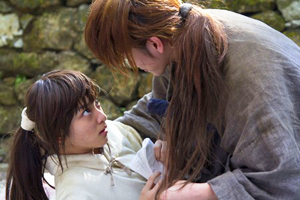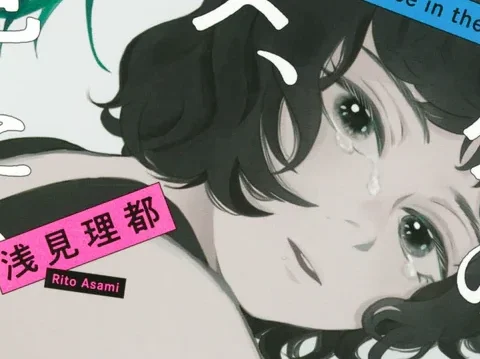
Just how much can a film hope to accomplish in two hours? Some hone in like a laser on one thing, seeking to make us laugh or cry, to make a point or defend a point of view, to create an atmosphere, or to thrill us with effects or action sequences. Others attempt to squeeze it all in, and while a select few actually manage to pull it off, most end up like the old cliche: “jack of all trades, master of none.”
Such were my thoughts after viewing Rurouni Kenshin, the new live-action adaptation of the popular manga, sometimes known as Samurai X on western shores.
 Set in Japan’s early Meiji period, Rurouni Kenshin is the tale of a wandering samurai named Kenshin who’s attempting to atone for his previous life as an assassin by performing good deeds. Kenshin, formerly known and feared as the killer Battosai, now refuses to take lives, carrying a sword called a “back-blade” with its dull and sharp sides reversed.
Set in Japan’s early Meiji period, Rurouni Kenshin is the tale of a wandering samurai named Kenshin who’s attempting to atone for his previous life as an assassin by performing good deeds. Kenshin, formerly known and feared as the killer Battosai, now refuses to take lives, carrying a sword called a “back-blade” with its dull and sharp sides reversed.
Ten years after giving up his former life, Kenshin wanders into Tokyo during a confluence of events. A merchant named Kanryu, who has benefitted from Japan’s recent embrace of western values (that is, capitalism), is flooding the streets with a new strain of opium, designed by his unwilling accomplice slash hostage, Megumi.
One of Kanryu’s bodyguards is Jin-e, a crazed samurai with supernatural powers who goes on murderous rampages using Kenshin’s former name, Battosai. His fighting style, taken from the pacifist Kamiya school, has caused a mass exodus of students from said school to the chagrin of its owner, the young Kaoru.
Kenshin gets wrapped up in all this, using his fighting prowess to defend Kaoru and Megumi against Kanryu and Jin-e without violating his principle rule: to never kill again.
Rurouni Kenshin’s cast and crew hail largely from the small screen. Director Keishi Ohtomo is a veteran TV drama director; this is his second feature film. Most of the actors are culled from dramas as well, including stars Takeru Sato (Kenshin) and Emi Takei (Kaoru).

As a result, the film, despite a reasonable budget (by Japanese live-action standards) has a very “TV” feel, with lots of close-ups and compositions that look framed for the small screen. The pacing is also quite TV-like, made up of segments that almost feel as if they should be separated by commercial breaks. In fact, the creators of the film have stated they’d like to make a live-action Kenshin series, and it’s hard not to see this as a kind of pilot film.
On the other hand, most of the drama stars do a perfectly good job with the material, especially Sato as Kenshin, who manages to go beyond his pretty-boy appearance and create a very likable main character. Oddly enough, the one truly annoyingly over-the-top performance comes from veteran film actor Teruyuki Kagawa (Kanryu), who earned accolades for his work in Tokyo Sonata a few years ago.
There’s plenty of good news here for fans of samurai films and of the Rurouni Kenshin franchise. For one thing, it’s a fairly faithful adaptation of the manga, covering most of the material from the first four volumes. Though some events have been moved around or compressed for time, the film definitely maintains the essence of the original work. The costume and makeup departments do a nice job, too, of retaining the look of manga without it looking out-of-place in the real world.
 Where Rurouni Kenshin stumbles, though, is in trying to have it all. It wants to be both a serious samurai drama and a supernatural mystery, it wants laughs in one scene and tears the next, and it’s packed full of weighty themes about capitalism, modernization and retribution but also implies we shouldn’t take it all too seriously.
Where Rurouni Kenshin stumbles, though, is in trying to have it all. It wants to be both a serious samurai drama and a supernatural mystery, it wants laughs in one scene and tears the next, and it’s packed full of weighty themes about capitalism, modernization and retribution but also implies we shouldn’t take it all too seriously.
You can’t fault a film for being ambitious, and Kenshin tries admirably to stuff it all in, but some of the tonal shifts from scene to scene and overall themes just don’t blend. Especially jarring are a few slow-motion, orchestra-blaring attempts at melodrama the film just doesn’t earn, leading my eyes to do more rolling than tear-letting.
The something-for-everyone approach has certainly worked so far: Rurouni Kenshin has raked in a healthy profit and is still doing gangbusters a few weeks after release, and fans of the manga and samurai action certainly have something to look forward to when the film inevitably hits western shores. But much like Kenshin’s sword, this two hour-plus, scattershot film could’ve benefitted from a little sharpening.
Fortunately, the first Rorouni Kenshin live-action was followed up with two sequels which were a massive improvement over the first! Don’t miss our reviews of Rurouni Kenshin: Kyoto Inferno, and Rurouni Kenshin: The Legend Ends.








